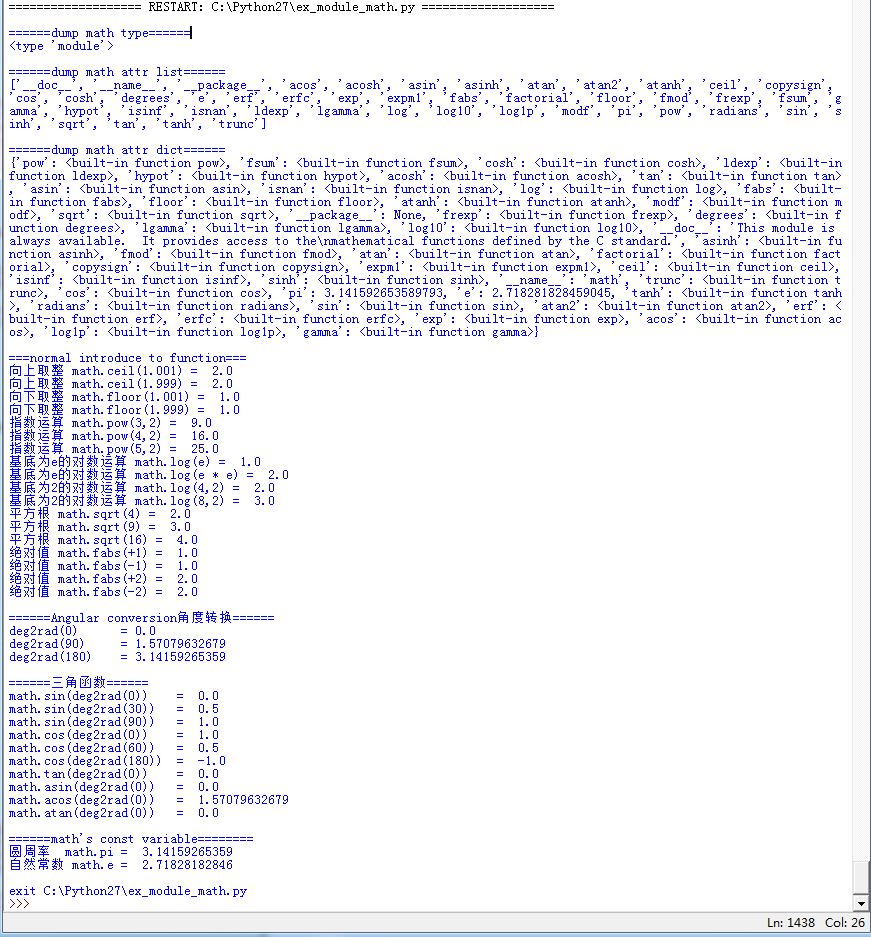【再回首Python之美】【模組 math】math模組的基本使用
阿新 • • 發佈:2019-01-04
學好數理化,走遍天下都不怕,所以一定要把Python的math模組學好。
math簡介
math提供兩個數學常量和眾多數學函式。這倆常量和眾多數學函式都是哪些呢?通過dir(math)一看便知。
使用math模組之前,一定要把模組包括進來,告訴編譯器我要開始使用math提供的變數和方法了。
import mathmath的兩個常量
print u"圓周率 math.pi\t= ",math.pi #3.14159265359
print u"自然常數 math.e\t= ",math.e #2.71828182846math的眾多函式
>>> dir(math) ['__doc__', '__name__', '__package__', 'acos', 'acosh', 'asin', 'asinh', 'atan', 'atan2', 'atanh', 'ceil', 'copysign', 'cos', 'cosh', 'degrees', 'e', 'erf', 'erfc', 'exp', 'expm1', 'fabs', 'factorial', 'floor', 'fmod', 'frexp', 'fsum', 'gamma', 'hypot', 'isinf', 'isnan', 'ldexp', 'lgamma', 'log', 'log10', 'log1p', 'modf', 'pi', 'pow', 'radians', 'sin', 'sinh', 'sqrt', 'tan', 'tanh', 'trunc'] >>>
math官方手冊地址
點選進入下面官方math手冊頁面,裡面包含所有的math 屬性,工作當中用到時可以查詢使用,很是方便。
示例程式碼
#coding:utf-8 #ex_module_math.py self_file = __file__ #save current file absulote path import math print "\n======dump math type======" print type(math) #<type 'module'> print "\n======dump math attr list======" print dir(math) #['__doc__', '__name__', '__package__', 'acos', 'acosh', 'asin', #'asinh', 'atan', 'atan2', 'atanh', 'ceil', 'copysign', 'cos', #'cosh', 'degrees', 'e', 'erf', 'erfc', 'exp', 'expm1', 'fabs', #'factorial', 'floor', 'fmod', 'frexp', 'fsum', 'gamma', 'hypot', #'isinf', 'isnan', 'ldexp', 'lgamma', 'log', 'log10', 'log1p', #'modf', 'pi', 'pow', 'radians', 'sin', 'sinh', 'sqrt', 'tan', #'tanh', 'trunc'] print "\n======dump math attr dict======" print math.__dict__ #{'pow': <built-in function pow>,……,'gamma': <built-in function gamma>} print "\n===normal introduce to function===" print u"向上取整 math.ceil(1.001) = ",math.ceil(1.001) #2.0 print u"向上取整 math.ceil(1.999) = ",math.ceil(1.999) #2.0 print u"向下取整 math.floor(1.001) = ",math.floor(1.001) #1.0 print u"向下取整 math.floor(1.999) = ",math.floor(1.999) #1.0 print u"指數運算 math.pow(3,2) = ",math.pow(3,2) #9.0 print u"指數運算 math.pow(4,2) = ",math.pow(4,2) #16.0 print u"指數運算 math.pow(5,2) = ",math.pow(5,2) #25.0 e = math.e print u"基底為e的對數運算 math.log(e) = ",math.log(e) #1.0 print u"基底為e的對數運算 math.log(e * e) = ",math.log(e * e) #2.0 print u"基底為2的對數運算 math.log(4,2) = ",math.log(4,2) #2.0 print u"基底為2的對數運算 math.log(8,2) = ",math.log(8,2) #3.0 print u"平方根 math.sqrt(4) = ",math.sqrt(4) #2.0 print u"平方根 math.sqrt(9) = ",math.sqrt(9) #3.0 print u"平方根 math.sqrt(16) = ",math.sqrt(16) #4.0 print u"絕對值 math.fabs(+1) = ",math.fabs(+1) #1.0 print u"絕對值 math.fabs(-1) = ",math.fabs(-1) #1.0 print u"絕對值 math.fabs(+2) = ",math.fabs(+2) #2.0 print u"絕對值 math.fabs(-2) = ",math.fabs(-2) #2.0 print u"\n======Angular conversion角度轉換======" #常識 0度(deg) == 0弧度(rad) #常識 90度(deg) == 1.5707964弧度(rad) #常識 180度(deg) == 3.1415927弧度(rad) def deg2rad(deg): #角度轉弧度 return math.radians(deg) def rad2deg(rad): #弧度轉角度 return math.degrees(rad) print "deg2rad(0)\t=",deg2rad(0) #0.0 print "deg2rad(90)\t=",deg2rad(90) #1.57079632679 print "deg2rad(180)\t=",deg2rad(180) #3.14159265359 print u"\n======三角函式======" #三角函式入參為弧度rad,計算角度的時候,需要先將角度轉弧度後計算 print "math.sin(deg2rad(0))\t= ",math.sin(deg2rad(0)) #0.0 print "math.sin(deg2rad(30))\t= ",math.sin(deg2rad(30)) #0.5 print "math.sin(deg2rad(90))\t= ",math.sin(deg2rad(90)) #1.0 print "math.cos(deg2rad(0))\t= ",math.cos(deg2rad(0)) #1.0 print "math.cos(deg2rad(60))\t= ",math.cos(deg2rad(60)) #0.5 print "math.cos(deg2rad(180))\t= ",math.cos(deg2rad(180))#-1.0 print "math.tan(deg2rad(0))\t= ",math.tan(deg2rad(0)) #0.0 print "math.asin(deg2rad(0))\t= ",math.asin(deg2rad(0)) #0.0 print "math.acos(deg2rad(0))\t= ",math.acos(deg2rad(0)) #1.57079632679 print "math.atan(deg2rad(0))\t= ",math.atan(deg2rad(0)) #0.0 print "\n======math's const variable========" print u"圓周率 math.pi\t= ",math.pi #3.14159265359 print u"自然常數 math.e\t= ",math.e #2.71828182846 print "\nexit %s" % self_file
編譯執行
(end)

